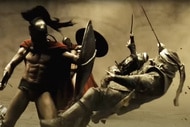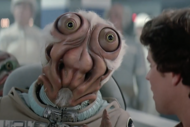14 years later, the aliens of Mass Effect still steal the show

The original Mass Effect, which has been remastered alongside its sequels in the newly released Legendary Edition, provides a great introduction to its sci-fi setting. The player-controlled character, Commander Shepard, has just come off of a mission that left them with psychic flashes of an alien race being slaughtered as they dock their ship, the SSV Normandy, at the Citadel. In the world of BioWare’s RPG franchise, this massive, pentagram-like space station is where Shepard can meet most of the sentient alien races that inhabit this world. More importantly, it’s also the first of many times that Shepard and the player are given a message — a message that’s the key to why the Mass Effect series works so well. The world is much bigger than you. And, it moves on, with or without you.
Science fiction and video games have been buddies for years, but the original Mass Effect came almost like a breath of fresh air in 2007. Compared to Halo, then the biggest sci-fi franchise for gaming, Mass 1 felt like such a stark contrast when it released because it gave you the space to interact with its aliens beyond beating them to death. Each race had relationships with one another outside of humanity, who they view with bemusement and mild irritation; when humans start getting snatched up or world-ending Reapers invade Earth at the beginning of the sequels, the aliens essentially tell humans “good luck,” or “sorry that happened.” Even if Shepard actively decides to put their people first, the other races pointedly remind players that humanity isn’t owed everything.
The galaxy of Mass Effect is a big one, and it’s well worth getting to know its people. Shepard can investigate these weird, bug-looking aliens called the Keepers on the Citadel, or they can go to a kiosk and chat it up with an elephant-like Elcor, a species that speaks in a monotone and has to use emotive statements to convey what they feel during a conversation. It’s viable to read the history of the universe through the in-game Codex tab of each game of the trilogy, but it’s more interesting to talk with NPCs who can flesh out the world more organically.
It also doesn’t hurt that some of the best aliens are in Shepard’s squad. Each game may start players off with a pair of OK humans, but things open up once you get an alien ally in your group. They also come with some of the more interesting missions, such as scaling a high-rise tower in Mass Effect 2 to recruit Thane, an assassin of the amphibious Drell race who have perfect memory recall. In Mass Effect 3, players can recruit the bewildering day one DLC character Javik, whose people the Protheans badly lost the previous war against the Reapers. Deeply cynical about this Reaper war and bitterly pointing out the evolution of “lesser” life forms like humans and Asari in his people’s absence, it’s worth chatting it up with him to break his cynical shell. As much as the trilogy is about humanity’s rise to galactic prominence, it’s the aliens who end up stealing the show, and the ones who step onto the Normandy are incredibly easy to love.
When Mass 3 was released with co-op, it finally allowed fans to play as their favorite aliens. That mode unexpectedly took off, in part because it was a blast, and also because players got to bring their understanding of the races into the characters they created. It’s one thing to see a burly, reptilian Krogan warlord or synthetic Geth lumber towards you on the battlefield, and another to wield that power of those enemies entirely in a fight against Reaper forces. Each species felt right at home in the class they were slotted into, and it was also a space where BioWare had some fun with their lore; future DLC made the insectoid Collector villains from Mass 2 playable, along with the comically short Volus, who live in suits of armor and breathe heavily at the end of each sentence.
After three games as a human, it felt like Mass Effect was ready for an alien protagonist. That wasn’t in the cards for 2017’s Andromeda, a spinoff set 600 years after the original trilogy in the new titular galaxy, and it’s to the game’s detriment. The native Angara sometimes feel comically hopeless to prop up the importance of the human Pathfinder Ryder. In their best moments, they feel like a real society, a lot of this thanks to your empathetic squadmate Jaal, and other times they feel like they solely exist to be a friendly alien race to interact within this new world. Concerns about the game stepping into colonialism are valid, but they’re somewhat pointed in the wrong direction. In truth, the villainous Kett are the actual colonizers and assimilating other races into their own, while the Milky Way aliens are unknowingly refugees sent into Andromeda to escape the Reaper war. But the game doesn’t make the latter point known unless you go into a lengthy quest to learn that for yourself. Locking this revelation to a side mission makes some sense (and it’s obvious if you’re a series fan), but the secrecy and the mixed tone of the Angara overall gives the game a weird energy that it can’t fully break from, even in its best moments.
With any luck, the next Mass Effect will let its aliens take center stage. They’re beloved for a reason, and BioWare has done this before with Dragon Age: Inquisition, where your race and class can affect your social standing. (Imagine being able to play Andromeda as the alien Pathfinders, it would’ve been great.) With two galaxies worth of potential, the universe of Mass Effect just got bigger — and its point of view has to get bigger along with it.



























